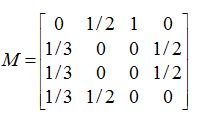利用Python搭建的简易排序搜索引擎
本文源代码转自搜索引擎原理,博主进行整理调BUG并进行注释,对于Python初学者来说是了解爬虫、网页排序算法非常好的素材。
首先来介绍一下PageRank网页排序算法(注:转自PageRank算法简介及Map-Reduce实现,详情点击链接):
PageRank对网页排名的算法,曾是Google发家致富的法宝。以前虽然有实验过,但理解还是不透彻,这几天又看了一下,这里总结一下PageRank算法的基本原理。
一、什么是pagerank
PageRank的Page可是认为是网页,表示网页排名,也可以认为是Larry Page(google 产品经理),因为他是这个算法的发明者之一,还是google CEO(^_^)。PageRank算法计算每一个网页的PageRank值,然后根据这个值的大小对网页的重要性进行排序。它的思想是模拟一个悠闲的上网者,上网者首先随机选择一个网页打开,然后在这个网页上呆了几分钟后,跳转到该网页所指向的链接,这样无所事事、漫无目的地在网页上跳来跳去,PageRank就是估计这个悠闲的上网者分布在各个网页上的概率。
二、最简单pagerank模型
互联网中的网页可以看出是一个有向图,其中网页是结点,如果网页A有链接到网页B,则存在一条有向边A->B,下面是一个简单的示例:
这个例子中只有四个网页,如果当前在A网页,那么悠闲的上网者将会各以1/3的概率跳转到B、C、D,这里的3表示A有3条出链,如果一个网页有k条出链,那么跳转任意一个出链上的概率是1/k,同理D到B、C的概率各为1/2,而B到C的概率为0。一般用转移矩阵表示上网者的跳转概率,如果用n表示网页的数目,则转移矩阵M是一个n*n的方阵;如果网页j有k个出链,那么对每一个出链指向的网页i,有M[i][j]=1/k,而其他网页的M[i][j]=0;上面示例图对应的转移矩阵如下:
初试时,假设上网者在每一个网页的概率都是相等的,即1/n,于是初试的概率分布就是一个所有值都为1/n的n维列向量V0,用V0去右乘转移矩阵M,就得到了第一步之后上网者的概率分布向量MV0,(nXn)*(nX1)依然得到一个nX1的矩阵。下面是V1的计算过程:
注意矩阵M中M[i][j]不为0表示用一个链接从j指向i,M的第一行乘以V0,表示累加所有网页到网页A的概率即得到9/24。得到了V1后,再用V1去右乘M得到V2,一直下去,最终V会收敛,即Vn=MV(n-1),上面的图示例,不断的迭代,最终V=[3/9,2/9,2/9,2/9]’:
现在应该能够基本理解PageRank算法了,那么附上代码:
#the search engine is divided into 3 modules:web crawl,build and use of index,page rank
#----------------------------web_crawl--------------------------------
def get_page(url):
try:
import urllib #引入urllib库
return urllib.urlopen(url).read() #打开网站并读取
except:
return "" #抛出异常
def get_next_target(page): #获取下一个链接网站
start_link = page.find('"') #str.find(str, beg=0 end=len(string)) 如果找到此方法返回的索引,否则返回-1;参数:此选项指定要搜索的字符串/这是开始索引,默认情况下为 0/这是结束索引,默认情况下它等于字符串的长度
if start_link == -1:
return None, 0
start_quote = page.find('"', start_link)
end_quote = page.find('"', start_quote + 1)
url = page[start_quote + 1:end_quote]
return url, end_quote
def get_all_links(page): #获取网页上面所有的url
links = [] #存取url的数组
while True:
url, endpos = get_next_target(page)
if url:
links.append(url)
page = page[endpos:]
else:
break
return links
def union(a, b): #并查集
for e in b:
if e not in a:
a.append(e)
def crawl_web(seed): # returns index, graph of inlinks
tocrawl = [seed]
crawled = []
graph = {} # , [list of pages it links to]
index = {}
while tocrawl:
page = tocrawl.pop()
if page not in crawled:
content = get_page(page)
add_page_to_index(index, page, content)
outlinks = get_all_links(content)
graph[page] = outlinks
union(tocrawl, outlinks)
crawled.append(page)
return index, graph
#--------------------------------build_index-----------------------------------
def add_page_to_index(index, url, content):
words = content.split() #str.split(str="", num=string.count(str)) 返回分割后的字符串列表
for word in words:
print word
add_to_index(index, word, url)
def add_to_index(index, keyword, url):
if keyword in index:
index[keyword].append(url) #存储url,类似map
else:
index[keyword] = [url]
def lookup(index, keyword): #查找索引
if keyword in index:
return index[keyword]
else:
return None
#---------------------------------page_rank---------------------------------
def compute_ranks(graph):
d = 0.8 # damping factor
numloops = 10
ranks = {}
npages = len(graph)
for page in graph:
ranks[page] = 1.0 / npages
for i in range(0, numloops):
newranks = {}
for page in graph:
newrank = (1 - d) / npages
for node in graph:
if page in graph[node]:
newrank = newrank + d * (ranks[node] / len(graph[node]))
newranks[page] = newrank
ranks = newranks
return ranks
def quick_sort(url_lst,ranks): #对网页权值进行快排, 不稳定
url_sorted_worse=[]
url_sorted_better=[]
if len(url_lst)<=1:
return url_lst
pivot=url_lst[0]
for url in url_lst[1:]:
if ranks[url]<=ranks[pivot]:
url_sorted_worse.append(url)
else:
url_sorted_better.append(url)
return quick_sort(url_sorted_better,ranks)+[pivot]+quick_sort(url_sorted_worse,ranks)
def ordered_search(index, ranks, keyword): #搜索结果排序
if keyword in index:
all_urls=index[keyword]
else:
return None
return quick_sort(all_urls,ranks)
#---------------------------------test-----------------------------------
index, graph = crawl_web('http://udacity.com/cs101x/urank/index.html')
ranks = compute_ranks(graph)
print ordered_search(index, ranks, 'Hummus')
#>>> ['http://udacity.com/cs101x/urank/kathleen.html',
# 'http://udacity.com/cs101x/urank/nickel.html',
# 'http://udacity.com/cs101x/urank/arsenic.html',
# 'http://udacity.com/cs101x/urank/hummus.html',
# 'http://udacity.com/cs101x/urank/index.html']
#print ordered_search(index, ranks, 'the')
#>>> ['http://udacity.com/cs101x/urank/nickel.html',
# 'http://udacity.com/cs101x/urank/arsenic.html',
# 'http://udacity.com/cs101x/urank/hummus.html',
# 'http://udacity.com/cs101x/urank/index.html']
#print ordered_search(index, ranks, 'babaganoush')
#>>> None哈哈哈,祝大家新年快乐,好好学习,天天向上~<( ̄ˇ ̄)/<( ̄ˇ ̄)/



